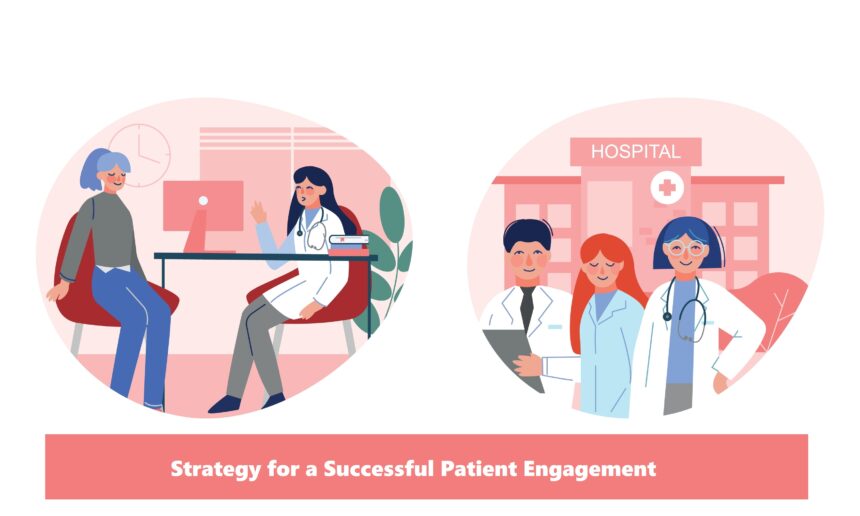There is no quick and easy way to implement a patient engagement plan. Constantly reaching out to patients is a necessary part of the process. It’s true that it’s impossible to click with every patient. Because of this, our target is not universal healthcare access, but rather a specific number of individuals.
What is Patient Engagement?
Effective patient engagement is an increasingly important topic in the healthcare sector and a key factor in improving overall health outcomes. With the right strategy, it is possible to ensure successful patient engagement. Patient engagement is the practice of involving patients in their healthcare decisions, from self-care and lifestyle modifications to treatment plans and long-term wellness journeys. Creating successful patient engagement strategies can improve patient outcomes, reduce medical costs, and increase satisfaction for all healthcare stakeholders.
This article will focus on strategies for patient engagement, discussing what it is and how to ensure success. It will explore best practices for engaging patients and provide insight into ways to foster a meaningful relationship between healthcare providers and patients.
1. Consider the long-term goals of your practice
Assessing current performance and future goals is the starting point for enhancing patient engagement. The status of patient participation in your practice is a topic worth discussing with your fellow doctors, medical staff, and shareholders. This may seem like a lot of work, but in the end, you’ll have a crystal clear picture of the definition you should be using in your career.
The next step is to develop a strategy for winning. In what state do you hope to find your practice in 12 months? In five years? How about in ten years? Your long-term plan should make it clear what kind of patient engagement approach you intend to use and how it will contribute to your business’s development.
You can construct your vision on several levels and in multiple time frames.
What is the meaning of patient engagement?
- Individuals, that seek out your services?
- Who are your squads?
- What is the scope of your practice?
All in all, it takes a group to get the job done. Only when individuals and groups work together will your patient engagement strategy succeed. Remember that the strength of the chain depends on the weakest link in it.
2. Create an active and involved culture first
Your entire practice must work together as one unit in order to give your patients the kind of stimulating experience they deserve. Having your team behind you will help you to ensure your patients are as involved as possible. The following are some suggestions for fostering an active practice culture:
- Get the message through to your employees that their input is welcome and appreciated.
- Discuss with them how a successful patient engagement approach may boost outcomes, income, and care.
- Make sure everyone on staff is adjusting well to their new roles and that nobody is feeling overwhelmed.
- Create a concise plan for patient participation. You can increase the likelihood of compliance with your policies if they are humorous rather than punitive.
The correct technology to aid your journey can be invested in after your entire team is on board and ready to take on the world.
3. Put Your Money Into Appropriate Technologies
It’s a common gripe that it’s hard to zero in on the precise technologies your business needs. Attempting it by hand is the way to go, in our opinion.
But before we get to the EMR software, let’s discuss the specific technologies we’re interested in.
Initially, there is a patient portal. A patient portal is an online communication and collaboration space between you and your patients. They have the same access to their medical history, can schedule visits, ask for prescription refills, and much more. For assistance in selecting an appropriate patient engagement portal, please refer to the following checklist.
Your patient portal, besides being intuitive and simple to use, should also have these qualities:
- Allow for online purchases to be made
- Message and signup services
- Be ICD-10 and Meaningful Use Stage 2 compliant.
- Make that your electronic health record (EHR), project management (PM), and billing system (Billing) all work together.
- Offer assistance to clients
4. Improve Patient Outcomes Through Education and Empowerment
The health of your patients is of paramount importance. The more their level of participation and sense of control, the greater their potential for recovery. Here are some suggestions to incorporate into your practice when working with patients:
- You should initiate the process. Utilize the patient portal to its fullest extent.
- Solicit their feedback on the patient portal and registration process.
- You can save time and effort by having both new and existing patients use your patient portal.
- If you suspect that your patient lacks technological confidence or is reluctant to attempt something new, you can take them by hand and show them how to use the patient portal.
- Keep in mind that not every client is tech-savvy. It’s possible that some people will always favor the tried-and-true methods of the past.
5. Track, Assess, Modify, and Repetition
Consider including goal-setting and evaluation in your strategy for patient engagement. Metrics tracking may benefit from initiating a discussion with patients about how a selected treatment plan would advance their health-related goals. How your patients can take use of modern medicine to get healthier in the long run.
If you’d rather not go the direct route, you may still keep track of how many people have signed up for your patient portal and what kinds of issues they ran into.
Finally, Improve Patient Participation in Your Practice
When it comes to patient engagement, most clinics believe that simply having access to state-of-the-art electronic medical record (EMR) software is sufficient. Patient engagement is more about how you choose to engage with patients than it is about having good electronic medical record software that streamlines your workflows and simplifies charting.
Throughout this article, we covered the five pillars of a successful patient engagement strategy and how you may incorporate them into your own practice. The ability to work together and share information with patients to enhance care is the crux of any successful patient engagement plan.








